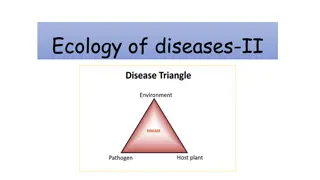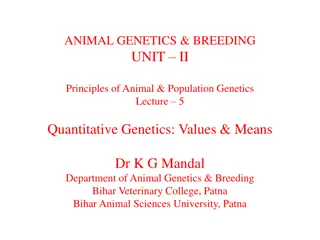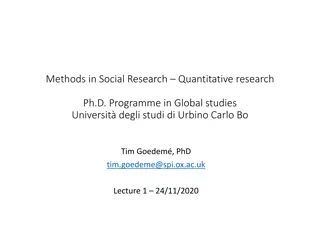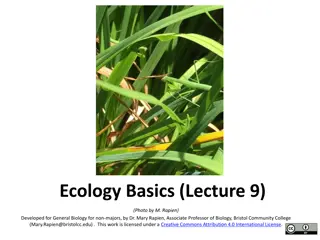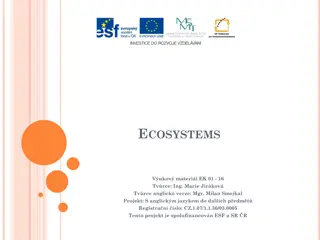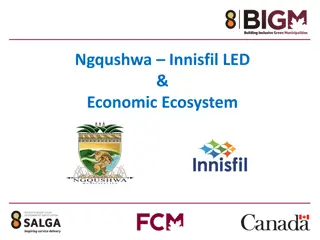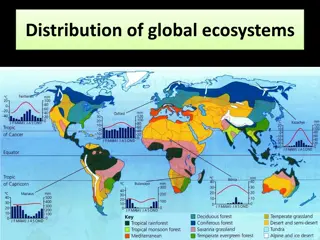Quantitative Study of Ecosystems: Techniques and Procedures
Exploring the study of ecosystems through quantitative methods like quadrat sampling and frequency analysis. Learn how to prepare, conduct fieldwork, and analyze data to understand the distribution of organisms in a selected ecosystem. This comprehensive guide covers learning objectives, safety measures, and transferring results to diagrams, graphs, and tables. Dive into the world of ecology with practical approaches for conducting meaningful research.
Download Presentation

Please find below an Image/Link to download the presentation.
The content on the website is provided AS IS for your information and personal use only. It may not be sold, licensed, or shared on other websites without obtaining consent from the author.If you encounter any issues during the download, it is possible that the publisher has removed the file from their server.
You are allowed to download the files provided on this website for personal or commercial use, subject to the condition that they are used lawfully. All files are the property of their respective owners.
The content on the website is provided AS IS for your information and personal use only. It may not be sold, licensed, or shared on other websites without obtaining consent from the author.
E N D
Presentation Transcript
Study of an Ecosystem Preparation Fieldwork Follow-up activities Report writing
Preparation Learning objectives Advance planning Safety
Quantitative Quantitative Study Study
Syllabus 1.5.3 Quantitative Study of plants and animals of a sample area of the selected ecosystem Transfer Results to Diagrams Graphs Tables Histograms Other relevant mode
Quantitative Study No. of organisms present Quadrat
Quadrat A frame that forms a known area Usually square shaped Can be used to measure: Frequency % Cover
Frequency The chance of finding a named organism within the sample area in a number of quadrats May be expressed as a percent of the total number of quadrats sampled
Frequency Procedure Throw the quadrat randomly in the sample area Record the presence or absence of a named organism within each quadrat Repeat for a number of throws Tabulate results
Frequency table Quadrat throw Organism 1 2 3 4 5 6 7 8 9 10 Total Frequency % Frequency . No of quadrats . containing organism = Frequency No of quadrats thrown If percentage is required multiply frequency by 100
Frequency Procedure Throw the quadrat randomly in the sample area Record the presence or absence of a named organism within each quadrat Repeat for a number of throws Tabulate results
Plot Graph % F r e q u e n c y X axis = Organisms Y axis = % Frequency Organisms
Tabulation of results Quadrat Throw Organism Name% Frequency 1 Buttercup Daisy Dandelion Grass 2 N Y N N 3 N N N Y 4 Y N Y Y 5 Y N Y N 6 N Y Y N 7 Y Y N N 8 N N Y Y 9 Y Y Y Y 10 N N N N Total Frequency % Frequency 5 4 6 4 50% 40% 60% 40% Y N Y N 5/10 4/10 6/10 4/10 50 40 60 40 % Frequency Auto 60% Calculations 50% 40% % Frequency 30% % Frequency 20% 10% 0% Buttercup Daisy Dandelion Grass Plant name
% Cover Quadrat divided into a grid Intersections form sampling points Plant scores a hit if touched by the needle Canopy organisms / all organisms
% Cover An area of ground occupied by aerial parts of individual plants of the species examined and counted Expressed as a percentage of the total quadrat area
% Cover procedure Throw a quadrat at random Record the plant hit at each sampling point Repeat for a number of throws Tabulate results
% Cover table Quadrat throw Plant Name 1 2 3 4 5 6 7 8 9 10 Total Hits Total Points % Cover No . of hits = % Cover 100 otal no . of po int s
% Cover procedure Throw a quadrat at random Record the plant hit at each sampling point Repeat for a number of throws Tabulate results
Tabulation of results Quadrat Throw Plant Name % Cover Buttercup Daisy Dandelion Grass Other 1 10 1 2 12 0 2 6 6 6 5 2 3 1 2 6 12 4 4 8 2 1 14 0 5 2 4 4 15 0 6 1 4 4 14 2 7 5 2 2 15 1 8 5 4 3 13 0 9 7 3 1 11 3 10 5 2 6 4 8 Total Hits Total Points % Cover 50 250 30 250 35 250 115 250 20 250 20% 12% 14% 46% 8% 20% 12% 14% 46% 8% % Cover Auto Calculations 8% 20% Buttercup Daisy Dandelion Grass Other 12% 46% 14%
Data Presentation ICT contributes to display, calculation and analysis of data. (example Excel) Density Density 8 Graphs 7 6 5 4 Density/m2 3 2 1 0 Analysis Buttercup Daisy Dandelion Grass Plant Name Calculations Spreadsheets Quadrat Throw - % Frequency Plant Name % Frequency Butercup Daisy Dandelion Grass 1 Y N Y N 2 N Y N N 3 N N N Y 4 Y N Y Y 5 Y N Y N 6 N Y Y N 7 Y Y N N 8 N N Y Y 9 Y Y Y Y 10 N N N N Total % Frequency 5 4 6 4 50% 40% 60% 40% 50% 40% 60% 40%
Syllabus page 14 1.5.7 Analysis Prepare a brief report of the results obtained
Report writing Option A Presentation of results and analysis of all ecology fieldwork together in portfolio format Option B Presentation of results of each individual ecology activity separately in regular practical notebook with one common analysis
Option A A portfolio should contain Title page Introduction Site description Methods used Results Analysis
Option B Presentation of results of each individual ecology activity separately in regular practical notebook with one common analysis








